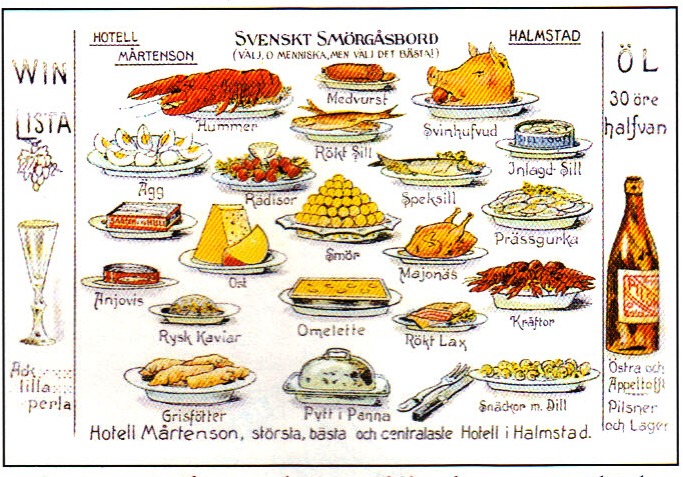

I'm a convert. A trip to Sweden convinced me that nothing -- not even your favorite champagne -- goes better with caviar than an ice-cold shot of good vodka. The same goes for all kinds of herring, smoked eel, gravlax and smoked salmon, crayfish and sharp, spiced cheese... the stuff a Swedish smorgasbord is made of. A chilled snaps prepares the palate for these salty or smoked delicacies, smooth but neutral alcohol cuts through the fat and balances the salt.
Several years ago, bacon-infused vodka made a big splash, lending panache to a category of "carnivorous cocktails." This year, Vivid Vodka, filtered through 12,000 pounds of virgin coconut husks, touts crystalline purity and is apparently a headliner in Vegas. But for me, the most interesting thing about vodka, is the food that it accompanies: Ergo, the history of the smorgasbord. In New York City in the '60s, my idea of heaven was to go with my family to the Scandia, or Stockholm restaurants and eat until I could eat no more.
A capsule history: In the 15th century vodka was a medicinal product. It was mixed with herbs and spices whose selection depended on whether you were curing a person or a horse. By the close of the 17th century, Swedes were consuming vodka as their natural beverage. It was a terrific social lubricant and they "drank" it out of a bowl with a very large spoon. Skal -- cheers -- means bowl. Snaps means to swallow quickly; a shot.
The world's first salad bar:
The smorgasbord, Sweden's gastronomic treasure, evolved out of something called the "aquavit buffet" or the "vodka table." From ancestral roots almost 300 years ago, the smorgas -- literally a slice of bread -- and bord -- a table -- grew into an elaborate presentation of 60 to 70 dishes that, after an international odyssey, evolved into today's enormously popular salad bars. In the 1700s when the tradition began, a social evening in Sweden began with men drinking branvin ("burnt wine") -- a name that included all distilled spirits but specifically vodka and flavored aquavits. While men waited for the women to adjust their clothing after a hard ride across country, they assembled around their host's "vodka table," drinking branvin and nibbling on a multitude of herrings -- sort of a Swedish tapas bar. As time went on, the vodka table become a competitive social phenomenon, with hosts straining to create the most lavish, largest presentations. So much so, according to an executive of V&S Vin & Sprit AB, the company that launched Absolut into the world, a royal decree was issued by the government to end the ruinous competition. Even at the turn of the century in restaurants in Sweden, "the vodka canteen" -- an elaborate silver fantasy dispensing several flavors of "branvin" -- was displayed at the center of the smorgasbord and guests were encouraged to eat and drink as much as they wanted. The canteen was affectionately known as Fritz. Vodka was included in the price of a meal -- but it was considered bad form to slug down more than half-a-dozen snaps.
How branvin became vodka:
The stuff that Swedes were slugging down with their herring in the early smorgasbord days was pretty low in quality and high in bothersome impurities. Spices, usually caraway, were added to make such snaps drinkable. A bright fellow named Lars Olsson brought from France a method of "rectifying" or cleaning branvin's impurities by continuous distillation: he produced a spirit that needed no flavoring (not even bacon!) and was free of objectionable fusel oil. In 1879 he created the brand "Absolut Rent Branvin," meaning absolutely pure branvin. It was only in the 1950s that the Swedes started calling the stuff "vodka" -- taking their cue from Smirnoff, which was the first company to market the spirit internationally.
Putting on the "fritz":
In this day of high operating costs and speedy business lunches, the smorgasbord is now more a symbol of Sweden than a reality, and you won't find many in America's cities, either. Stockholm is down to just a handful -- the most famous being the Operakällaren (the Opera Cellar.) After all, according to the Stockholm Restaurant Academy, a proper smorgasbord must have at least 12 preparations of Baltic and Atlantic herring plus graved laks (literally "buried salmon") and other smoked and poached salmons. Then comes the smoked and cured meats, the hot course, and dessert. Each trip to the table should be accompanied by a clean plate and at least five trips should be made. That's far more costly than a crayfish taco. The Guinness Book of Records certified that the world's biggest smorgasbord measured over 1207 feet long with less than two inches between the serving dishes. Imagine the fun. And while vodka producers continue to duke it out with claims of virgin birch charcoal filtration and aroma-therapy flavors, I say, bring back "Fritz" -- and you'll sell more vodka than one thought imaginable. Skal.
Rozanne Gold, award-winning chef and author of "Eat Fresh Food: Awesome Recipes for Teen Chefs"; "Healthy 1-2-3," and "Radically Simple."
Rozanne can be found on Facebook at www.facebook.com/RozanneGold.
